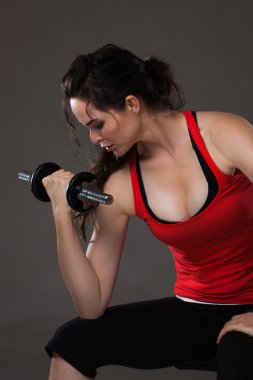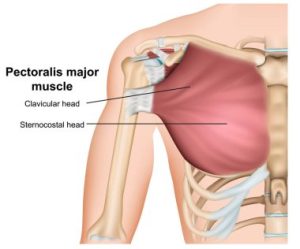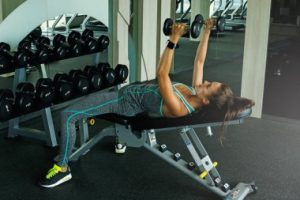
Can Chest Exercises Make Breasts Perkier (6 Important Facts)
Can chest exercises make breasts perkier? This intriguing question has sparked curiosity and debate among fitness enthusiasts and those seeking natural ways to enhance their appearance. Imagine achieving a firmer, more lifted bust without the need for surgery or expensive treatments—just the power of targeted exercises!
Chest workouts, often associated with strengthening the pectoral muscles, might hold the key to a naturally perkier chest. These exercises can tone and build the underlying muscles, potentially giving the breasts a more lifted and youthful look. Dive into the science and strategies behind this fitness phenomenon and discover how simple, effective exercises might transform not just your chest, but your confidence and posture as well.

Can Chest Exercises Make Breasts Perkier
Yes, chest exercises can make breasts appear perkier. While these exercises won’t increase breast size since breasts are made of fatty tissue, they can enhance the underlying pectoral muscles. This improvement can lead to a lifted and firmer appearance. Key exercises such as push-ups, chest presses, and flyes target these muscles effectively. Regular strength training combined with proper form can yield noticeable results.
Benefits of Chest Exercises for Perkier Breasts
Chest exercises play a crucial role in toning and strengthening the pectoral muscles located beneath the breasts. These muscles, when developed, provide a natural lift, creating a firmer and perkier look. Engaging in consistent workouts like push-ups, bench presses, and chest flyes helps in enhancing muscle definition, which directly impacts the overall appearance of the chest area. The enhanced muscle tone not only improves the aesthetics but also contributes to better posture, giving an added lift to the breasts. Incorporating resistance bands or weights can further intensify these workouts, leading to more pronounced results.
Best Chest Exercises for Perkier Breasts
Several exercises specifically target the pectoral region, making them ideal for those seeking a perkier breast appearance. Push-ups are a classic exercise that not only works the chest but also engages the arms and core, promoting overall upper body strength. Variations like incline or decline push-ups can add diversity to the routine and challenge the muscles in different ways.
Chest presses, performed with dumbbells or a barbell, are another excellent choice. These exercises focus on pushing movements that enhance the pectoral muscles, contributing to a firmer chest. Additionally, chest flyes, which involve extending the arms out to the sides and bringing them together, effectively target the inner and outer pectoral muscles, ensuring comprehensive development.
Combining Chest Exercises with Overall Fitness
While chest exercises are pivotal for a perkier breast appearance, they should be part of a well-rounded fitness regimen. Including cardiovascular activities like running, cycling, or swimming helps in burning overall body fat which can accentuate the results of strength training. Maintaining a balanced diet rich in protein supports muscle growth and repair, further enhancing the effects of your workouts. Consistency is key; regular exercise, proper nutrition, and adequate rest are essential components of any fitness goal, including achieving perkier breasts.
Anatomy of the Breast and Chest Area
Structure of the breast
The anatomy of the breast and chest area is a complex interplay of various tissues and structures that serve both functional and aesthetic roles. The breast itself is primarily composed of fatty tissue, glandular tissue, and connective tissue, each playing a crucial part in its overall structure and function. Fatty tissue, or adipose tissue, makes up a significant portion of the breast, giving it its size and shape. This tissue acts as a cushion and provides protection for the underlying structures.
Glandular tissue, on the other hand, is responsible for the breast’s primary function: milk production. This tissue is organized into lobes and lobules, which are connected to the nipple by a network of ducts. The glandular components are particularly dense in women of childbearing age, reflecting their role in lactation. Connective tissue, including fibrous bands known as Cooper’s ligaments, provides structural support to the breast, helping to maintain its shape and position on the chest wall.
Unlike other parts of the body, the breast tissue itself does not contain muscle. Instead, it rests on the pectoral muscles of the chest, which are involved in the movement and support of the upper body. These muscles, such as the pectoralis major and pectoralis minor, are covered by a layer of fascia that separates them from the breast tissue.
The absence of muscle within the breast tissue itself means that changes in the breast’s shape and firmness are primarily due to the varying proportions and conditions of the fatty, glandular, and connective tissues, rather than muscular development. This anatomical configuration underscores the unique nature of the breast, distinguishing it from other body parts that rely more heavily on muscle for their structure and function.
Chest muscles
The anatomy of the breast and chest area is complex and involves a detailed interplay between various tissues, muscles, and glands. The breasts are located on the anterior thoracic wall, overlying the pectoralis major muscles. The pectoralis major is a thick, fan-shaped muscle situated at the chest (anterior) of the human body. It makes up the bulk of the chest muscles and lies under the breast tissue.
This muscle has two parts: the clavicular head, originating from the clavicle (collarbone), and the sternal head, originating from the sternum (breastbone) and the cartilages of the first six ribs. The pectoralis major plays a crucial role in the movement of the shoulder joint, enabling actions such as flexion, adduction, and internal rotation of the humerus.
Directly beneath the pectoralis major lies the pectoralis minor, a thinner, triangular muscle that originates from the third to fifth ribs and inserts onto the coracoid process of the scapula (shoulder blade). The pectoralis minor stabilizes the scapula by drawing it anteroinferiorly against the thoracic wall and aids in movements such as protraction and downward rotation of the scapula. In relation to the breast, these muscles provide structural support and play a role in the positioning of the breast tissue on the chest wall.
The breast itself is composed of glandular tissue, which produces milk, and adipose tissue, which provides shape and support. The glandular tissue is organized into lobes and lobules connected by a network of ducts that converge at the nipple. Understanding the anatomy of the pectoralis major and minor is essential, not only for comprehending the mechanics of upper body movements but also for recognizing how breast tissue overlays and interacts with the underlying musculature, which is particularly relevant in medical fields such as surgery, oncology, and rehabilitation.

Skin and ligaments
The breast and chest area is a complex and intricate structure comprising skin, glandular tissue, connective tissue, and ligaments, all working together to support and define the shape and function of the breast. One of the key components of this anatomical structure is Cooper’s ligaments, also known as suspensory ligaments.
These fibrous bands of connective tissue extend from the clavicle and the underlying pectoral fascia through the breast tissue, anchoring to the skin overlying the breast. They provide structural support, helping to maintain the shape and firmness of the breast by creating compartments that support the glandular tissue. The integrity and tension of Cooper’s ligaments play a crucial role in preventing the breast from sagging, contributing to the overall contour and appearance.
Another significant factor affecting breast shape is the elasticity of the skin. The skin enveloping the breast is composed of the epidermis, dermis, and subcutaneous tissue, which provide not only protection but also elasticity and flexibility. The elasticity of the skin is influenced by factors such as age, genetics, hormonal changes, and environmental factors like sun exposure.
High skin elasticity helps to maintain the breast’s youthful shape and firmness, whereas reduced elasticity, often due to aging or overstretching, can lead to sagging and changes in contour. Together, Cooper’s ligaments and the elasticity of the skin work synergistically to preserve the breast’s structural integrity and aesthetic appearance, highlighting the intricate interplay between the different anatomical components in the breast and chest area.
Mechanisms Behind Breast Perkiness
Factors influencing breast perkiness
Breast perkiness is influenced by a combination of factors including genetics, age, weight fluctuations, and pregnancy and breastfeeding. Genetics play a significant role as they determine the inherent characteristics of breast tissue, including skin elasticity and the density of glandular versus fatty tissue. Individuals with a higher proportion of glandular tissue tend to have firmer breasts, while those with more fatty tissue may experience less natural lift.
Age is another crucial factor; as women age, the connective tissues and ligaments, known as Cooper’s ligaments, that support the breasts naturally lose elasticity and strength. This, coupled with the thinning of the skin and loss of collagen, often results in sagging.
Weight fluctuations can also affect breast perkiness, as gaining and losing weight repeatedly can stretch the skin and affect its ability to bounce back, leading to a loss of firmness. Pregnancy and breastfeeding significantly impact breast shape and perkiness as well. During pregnancy, hormonal changes cause the breasts to enlarge, stretching the skin and tissues.
After breastfeeding, the breasts may not return to their pre-pregnancy size or shape, often leading to a loss of firmness and sagging. Overall, while genetics set the baseline for breast characteristics, life events and lifestyle factors can significantly alter their perkiness over time.
Role of chest muscles in breast support
Breast perkiness is largely influenced by the underlying chest muscles, particularly the pectoral muscles. These muscles provide foundational support to the breast tissue, which does not contain muscle itself. Well-toned pectoral muscles can contribute to a lifted and firmer appearance of the breasts. Regular exercises that target these muscles, such as push-ups, chest presses, and chest flies, can enhance muscle tone and improve the structural support for the breasts. This increased muscle tone helps in maintaining a youthful and perky appearance by providing a firmer base beneath the breast tissue.
Additionally, the condition of the chest muscles affects the overall chest appearance, creating a more defined and sculpted look. Strong pectoral muscles can enhance the contour and symmetry of the chest, giving the breasts a higher and more prominent positioning. Conversely, weak or underdeveloped chest muscles can lead to a less supported and potentially saggy breast appearance. Therefore, maintaining good muscle tone through regular exercise is essential for both the aesthetic appearance of the breasts and the overall definition of the chest area.
Impact of Chest Exercises on Breast Appearance
Strengthening chest muscles
Breast perkiness is primarily influenced by the structure and integrity of the breast tissue and the skin’s elasticity. Unlike other parts of the body, breasts do not contain muscles but are composed of glandular tissue, fat, and connective tissue. The firmness and shape of the breasts are largely determined by the Cooper’s ligaments, which are bands of connective tissue that support the breast tissue and maintain its shape.
However, the underlying pectoral muscles, particularly the pectoralis major and minor, can indirectly affect the appearance of the breasts. Engaging in chest exercises can help to enhance the underlying muscle tone, thereby providing a more lifted and firmer appearance to the breasts.
Exercises such as push-ups, chest presses, and chest flies are particularly effective in targeting these muscles. Push-ups, for instance, engage the pectoral muscles along with the shoulders and triceps, contributing to an overall strengthening of the upper body. Chest presses and chest flies, performed with dumbbells or on a machine, specifically target the pectoral muscles, helping to build and tone the chest area.
As these muscles become stronger and more defined, they can help to lift the breast tissue and improve overall breast shape and firmness. Regularly incorporating these exercises into a fitness routine can not only enhance the aesthetic appearance of the breasts but also improve posture and upper body strength, contributing to a more youthful and perky breast appearance over time.

Indirect effects on breast perkiness
Engaging in chest exercises such as push-ups, chest presses, and dumbbell flyes can indirectly impact breast perkiness by enhancing the tone and strength of these pectoral muscles. As these muscles become more defined, they provide a firmer base for the breast tissue, contributing to a lifted and more youthful appearance.
Moreover, regular exercise promotes better posture by strengthening the muscles of the back, shoulders, and core. Improved posture pulls the shoulders back and opens up the chest, which can make the breasts appear higher and more prominent. This combination of enhanced muscle tone and better posture creates an overall effect that makes the breasts look perkier, despite the exercises not directly affecting the breast tissue itself. In addition to aesthetic benefits, these exercises contribute to overall physical health, supporting the skeletal structure and reducing the risk of back pain and other posture-related issues.
Myths vs. realities
Chest exercises can significantly influence the appearance of breasts, but it’s essential to separate myths from realities. A common misconception is that chest exercises can increase breast size. In reality, breasts consist mostly of fatty tissue, and while exercises like push-ups, chest presses, and flyes can strengthen and build the underlying pectoral muscles, they do not directly enlarge breast tissue. However, these exercises can enhance the overall shape and firmness of the chest area, potentially lifting and improving the contour of the breasts, giving them a more youthful and lifted appearance.
Another myth is that chest exercises can reduce breast size. While these exercises alone do not reduce breast tissue, they can contribute to an overall leaner physique if combined with a comprehensive fitness and diet regimen, which may result in some reduction in breast size due to fat loss.
Realistic expectations from chest exercises include improved posture, increased upper body strength, and a more toned appearance of the chest muscles, which can subtly enhance the look of the breasts. It’s crucial to understand that while chest exercises offer numerous benefits, they should be part of a balanced workout routine for overall health and fitness rather than solely for altering breast appearance.
Comprehensive Chest Workout Routine
Effective chest exercises
Effective chest exercises include push-ups, which are versatile and can be performed in various forms such as standard, incline, and decline to target different parts of the chest. The chest press, whether performed with dumbbells or a barbell, is another fundamental exercise that promotes muscle growth and strength. Proper technique is crucial to maximize benefits and avoid injury.
Chest flies, which involve a wide, sweeping motion with weights, effectively isolate and stretch the pectoral muscles, fostering muscle development and flexibility. Finally, dumbbell pullovers, which target both the chest and back muscles, are excellent for building a balanced upper body while also expanding the rib cage and improving posture. By incorporating these exercises into a regular fitness routine and focusing on proper form, individuals can achieve a well-defined chest that may contribute to a more lifted and perky appearance of the breasts.
Frequency and intensity
For optimal results, a chest workout should be performed two to three times per week, allowing at least 48 hours of recovery between sessions to promote muscle repair and growth. Each session should include a variety of exercises targeting all areas of the chest, such as bench presses, push-ups, chest flyes, and cable crossovers.
The importance of progressive overload cannot be overstated; this principle involves gradually increasing the weight, resistance, or repetitions over time to continually challenge the muscles, thereby encouraging growth and strength gains. By progressively overloading the chest muscles, you stimulate hypertrophy and endurance, which leads to more significant and sustained improvements.
Additionally, incorporating different angles and grips in your exercises ensures a balanced development of both the pectoralis major and minor muscles, enhancing the overall contour and firmness of the chest. Although direct exercise of the chest muscles won’t change the structure of breast tissue, which is largely composed of fat and glands, it can improve the underlying pectoral muscles, potentially giving the breasts a lifted and firmer appearance. To maximize benefits, it’s crucial to combine this workout routine with a balanced diet rich in protein, proper hydration, and adequate rest.

Incorporating full-body workouts
While chest exercises themselves do not directly affect the breast tissue, they do target the pectoral muscles that lie beneath the breasts. Strengthening these muscles can provide a more lifted and firmer appearance to the chest area. Incorporating a variety of chest exercises, such as bench presses, push-ups, chest flies, and cable crossovers, can effectively target all areas of the pectoral muscles.
Additionally, incorporating full-body workouts into your routine is crucial for a balanced approach to fitness. This not only ensures that the chest muscles develop proportionately with other muscle groups but also supports overall muscle tone and body composition.
Full-body workouts improve cardiovascular health, enhance metabolic rate, and prevent imbalances that could lead to injury. A well-rounded fitness regimen, combining chest-focused exercises with compound movements like squats, deadlifts, and rows, promotes optimal physical health and aesthetic goals. By integrating both targeted and holistic exercise strategies, you can achieve a balanced and well-defined physique, supporting overall strength, endurance, and an improved body composition.
Additional Factors to Consider
Nutrition and hydration
It is essential to consider additional factors such as nutrition and hydration in this process. A balanced diet rich in vitamins, minerals, and proteins plays a crucial role in maintaining skin elasticity and aiding muscle recovery. Nutrients such as vitamin C, vitamin E, collagen, and omega-3 fatty acids support the skin’s structural integrity and resilience, while proteins are vital for muscle repair and growth.
Adequate hydration is equally important, as water helps maintain skin moisture and elasticity, preventing sagging and dryness. Moreover, maintaining a healthy weight is crucial, as significant weight fluctuations can stretch the skin and lead to loss of firmness. Combining regular chest exercises with a nutritious diet and proper hydration can, therefore, promote a more lifted and youthful appearance of the breasts by supporting both muscle tone and skin health.
Skin care and support
It’s essential to note that the breasts themselves are primarily composed of fatty tissue and glands, not muscle. Therefore, while exercise can enhance muscle tone and improve overall chest appearance, it may not directly alter the size or firmness of the breasts themselves. Other factors, such as genetics, age, and hormonal changes, also play significant roles in breast shape and firmness.
Additionally, maintaining good skin care practices, such as moisturizing and using sun protection, can support skin elasticity and overall breast health. Wearing supportive bras, particularly during exercise, helps minimize bouncing and strain on the ligaments, which can help maintain breast shape and prevent sagging over time. These holistic approaches, combined with targeted exercise, contribute to supporting breast health and appearance.
Lifestyle choices
Lifestyle choices such as smoking and excessive alcohol consumption can negatively impact skin elasticity, potentially affecting breast firmness. Additionally, maintaining a healthy weight through balanced nutrition and regular exercise can also support overall breast health. Therefore, while chest exercises can be beneficial, a holistic approach that includes maintaining a healthy lifestyle and avoiding habits detrimental to skin elasticity is essential for achieving and maintaining perkier breasts.
FAQ: Can Chest Exercises Make Breasts Perkier
Q1. Can chest exercises actually make my breasts perkier?
A. While chest exercises can’t directly change the shape or firmness of your breasts (which are composed mainly of fatty tissue and mammary glands), they can strengthen the pectoral muscles underneath. This can enhance the overall appearance by providing a lift and making the chest area look firmer.
Q2. What kind of chest exercises are best for a perkier look?
A. Exercises like push-ups, chest presses, and chest flies are excellent for targeting the pectoral muscles. Incorporating these into your regular workout routine can help tone and strengthen these muscles, potentially improving the appearance of your breasts.
Q3. How often should I do chest exercises to see results?
A. For noticeable results, aim to include chest exercises in your workout routine 2-3 times a week. Consistency is key, along with gradually increasing the intensity of your workouts as you build strength.
Q4. Are there any risks associated with chest exercises?
A. Like any exercise, there’s a risk of injury if performed incorrectly. Ensure you use proper form and technique to avoid strains or injuries. It might be beneficial to consult a fitness professional or personal trainer when starting a new exercise regimen.
Q5. Will chest exercises reduce the size of my breasts?
A. Chest exercises themselves won’t reduce breast size, but if you lose overall body fat through regular exercise and a healthy diet, your breasts might appear smaller since they are partly made up of fatty tissue.
Q6. Can women of all ages benefit from chest exercises?
A. Yes, women of all ages can benefit from strengthening their chest muscles. It’s never too late to start exercising and improving muscle tone. However, older adults should take care to start slowly and possibly consult with a healthcare provider before beginning a new exercise program.
Q7. Do I need any special equipment for chest exercises?
A. While some chest exercises can be performed without any equipment, such as push-ups, others might require dumbbells, resistance bands, or a bench. Using a variety of equipment can help target the chest muscles more effectively.
Q8. How long will it take to see improvements in the perkiness of my breasts?
Results can vary depending on factors like your starting fitness level, how consistently you exercise, and your overall lifestyle. Generally, you may start to see some improvement in muscle tone and lift within a few weeks to a couple of months.
Q9. Can chest exercises help with sagging breasts after pregnancy?
A. Chest exercises can help strengthen and tone the muscles underneath the breasts, which might improve the appearance of sagging. However, they won’t change the skin’s elasticity or significantly alter the breast tissue affected by pregnancy and breastfeeding.
Q10. What other benefits do chest exercises provide?
A. Besides potentially enhancing the appearance of your breasts, chest exercises improve overall upper body strength, posture, and can contribute to better overall fitness. Strong chest muscles are essential for various daily activities and athletic performance.
Conclusion
In conclusion, while chest exercises primarily target the pectoral muscles, they can indirectly contribute to a perkier appearance of the breasts. These exercises help to strengthen and tone the muscles beneath the breasts, providing better support and potentially lifting the breast tissue.
However, it’s important to note that chest exercises alone cannot change the actual size or shape of the breast tissue itself, which is largely composed of fat and glandular tissue. For optimal results, combining chest exercises with a comprehensive fitness routine, healthy diet, and proper posture can enhance the overall appearance of the chest area. Additionally, wearing well-fitted supportive bras can also make a significant difference in maintaining a perky appearance.